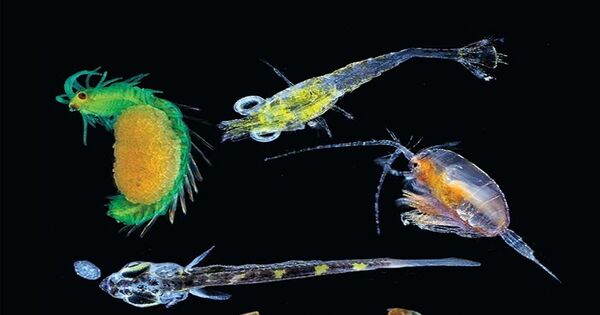A novel model connects the rules of life at the individual and ecological levels, potentially opening up new areas of research in ecology, global change biology, and, ultimately, ecosystem management.
Researchers at Michigan State University and the Carnegie Institution for Science have created a model that combines microscopic biology and macroscopic ecology, potentially deepening our understanding of nature’s laws and creating new options for ecosystem management.
On February 16, the researchers published a paper in the journal Science demonstrating how minute plankton correlations, such as those between an organism’s size and nutrient consumption, scale up to reliably alter food webs.
The study provides new avenues of research that could enhance prediction of how ecosystems, and the relationships among the organisms in them, will change with eco-evolutionary dynamics interacting in changing environments.
Steve Dudgeon
“Using data that other researchers have measured at the microscale about these organisms, our model can predict what’s happening at the scale of whole ecosystems,” said Jonas Wickman, a postdoctoral research associate with MSU’s College of Natural Science and first author of the new paper.
“We can now show how lower-level rules of life feed into these higher levels based on ecological interactions and evolutionary considerations,” explained Elena Litchman, a senior staff scientist at Carnegie’s Biosphere Sciences and Engineering division. “Up until now, people had mostly considered these levels in isolation.”
This new study will allow the team and its peers to create new experiments to test, develop, and expand the model by applying it to other species and environments. This could eventually lead to the model being used to influence ecosystem management techniques in a variety of settings around the world.

Small organisms, global impact
The team is also interested in what more they can learn from their model and the plankton they study. “We chose them as a model system for a few reasons,” said Christopher Klausmeier, an MSU Research Foundation Professor at the W. K. Kellogg Biological Station. He’s also a faculty member with the Department of Plant Biology, the Department of Integrative Biology and the Ecology, Evolution and Behavior, or EEB, program at MSU.
One of the reasons is that plankton are the primary research focus for the research group led by Litchman and Klausmeier. “They’re relatively simple organisms. If anything is going to follow the rules, plankton are a good candidate,” Klausmeier said. “But they’re also globally important. They’re responsible for about half of the primary production on Earth and are the base of most aquatic food webs.”
Primary producers use biochemical processes like photosynthesis to convert the Earth’s carbon and raw ingredients into chemicals that benefit both the organisms themselves and their predators. This means that plankton play an important role in the natural mechanism that cycles the planet’s vital components, such as carbon, nitrogen, and oxygen.
Having a scaling model that depicts plankton can help us better understand those critical processes, as well as if and how they are changing with the planet’s climate. The researchers did not incorporate climate-related variables such as temperature in this analysis, but they are already planning future steps in that direction.
“The effects of global warming could alter the lower-level physiological processes,” Litchman said. “We could then use this framework to see how those effects bubble up to different levels of organization.”
Eye-popping simplicity
Wickman hasn’t always been a plankton ecologist. His undergraduate degree was in physics, but he switched to ecology during his doctoral studies in Sweden before joining the Klausmeier-Litchman lab in 2020. The team said his physics background shaped his approach to developing this model, which Litchman described as “beautiful — stripping out everything except the essential processes.”
To begin, Wickman built from fundamental theories describing his system of interest. Only in this case, the system wasn’t, say, quantum mechanical particles. It was tiny organisms linked by a simple food web. Within that web, phytoplankton are the primary producers and zooplankton are their predators.
“Well, grazers really,” Wickman said of the zooplankton. “We don’t usually call cows predators of grass.”
To properly understand how this vital link works and its worldwide consequences, researchers have broken it down into its ecological and evolutionary components. For example, microscopic factors such as a phytoplankton’s size determine its capacity to compete for resources, which influences how big cells can grow and how likely it is to become food for zooplankton. These microscopic elements are thus linked to macroscopic variables such as nutrient distribution and the density or sparsity with which various types of plankton inhabit their habitats.
Over the past several decades, scientists have formulated mathematics that describe important relationships at the micro scale and macro scale individually. Attempts to bridge the scales, however, have left researchers wanting, Wickman said.
That’s because previous attempts to make that connection have had to make compromises. Some previous models have chosen simplicity at the expense of accuracy and realism. Others have confronted that complexity with brute computational force, making them less accessible and harder to work with.
“Our model includes actual ecological and evolutionary mechanisms but is simple enough to use,” Wickman told me. The work began as pure theory, but Litchman proposed that it be feasible to validate its predictions with current data. “When I saw how well the model matched the observations, my eyes popped out,” she went on to say.
The team had been working on this subject for several years, with funding from the United States National Science Foundation, or NSF, and had previously published a study creating the eco-evolutionary modeling approaches on which they depended. Now, the team has demonstrated the model’s potential by combining it with real-world data.
“The revelation that patterns emerging at macroecological scales can be explained by properties of individual organisms at microecological scales is as compelling as it is elegant,” said Steve Dudgeon, program director in the NSF’s Directorate for Biological Sciences, which assisted in funding the research.
“The study provides new avenues of research that could enhance prediction of how ecosystems, and the relationships among the organisms in them, will change with eco-evolutionary dynamics interacting in changing environments.”
















